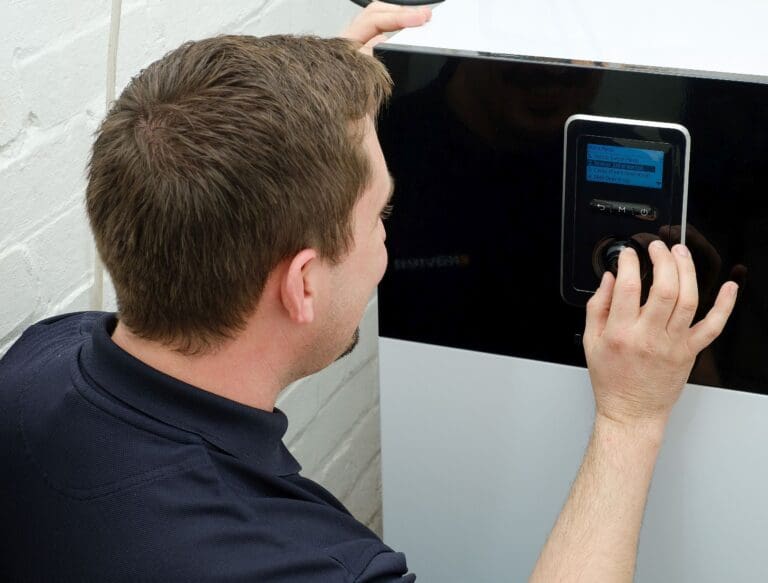
Homeowners will not have to make the switch to low-carbon alternatives such as heat pumps until such time that their oil boiler needs replacing after 2035, however, for those that want to make the switch now, the Government has increased cash grants for the Boiler Upgrade Scheme by 50% up to £7,500.
While this delay provides the industry with an opportunity to educate itself and its customers about the sustainable and efficient alternatives that can be used once the ban is in place, now is also a good time for installers to show their customers how they can best maximise the performance of their oil-fired boiler.
Sean Keleher, technical director at Navien UK, discusses the benefits of oil-fired appliances and how installers can help their customers maximise performance.
Yellow or blue flame
Oil-fired boilers are an efficient way of providing heating and hot water throughout the home and are often found in more rural areas where gas infrastructure is non-existent. In fact, as oil burns at a higher temperature, oil-fired boilers can heat homes more quickly than alternative options while using less fuel to do so, making them more efficient.
The two main types of oil boilers on the market are yellow and blue flame. Yellow flame indicates incomplete combustion, while blue flame indicates complete combustion, producing a much hotter and cleaner flame. Not only this, but blue flame oil boilers have a much lower NOx emissions rate compared to yellow flame, meaning they are more efficient and have cheaper running costs.
Maximised performance
For homeowners with an oil-fired heating system, there are several ways installers can help them to maximise the performance of the boiler, reduce their running costs and their energy bills.
Most combi boilers will reach temperatures as high as 800C for domestic heating circulation. However, regardless of the fuel used to power the system, these temperatures are too high for appliances to maintain an A+ ErP rating. It is only when flow temperatures are below 600C that the boiler can reach the desired rate of higher efficiency.
By reducing the operational flow rate temperature and giving the boiler a chance to run in condensing mode, installers can help homeowners maximise performance and reduce their energy bills.
Navien’s LCB700 Blue Flame oil-fired combi boiler is the UK’s first oil boiler to offer an A+ energy rating when installed with a Navien Smart Plus Controller or equivalent, producing a NOx emission rate as low as 57.2mg/kWh – one of the lowest in the industry. With a built-in flow adjustment valve, the boiler ensures hot water is available on demand but won’t preheat the system until it has recognised the homeowner’s usage habits.
In addition to its zoning capabilities which allow individual spaces to be heated to a specific temperature, the Smart Plus Controller houses a Smart Forecast and Geofencing tool, both of which ensure that the boiler only uses energy when needed.
Smart Forecast harnesses data from OpenWeatherMap to respond intuitively to the current local weather conditions to ensure the home remains at a comfortable temperature, without user interaction. Its Geofencing capability allows users to switch the boiler on or off, purely based on their proximity from their home which can be set up to a maximum of 5km – a particularly useful feature when returning home from work.
The LCB700 is also designed to use the store first until it is required to add heat – reducing fuel usage and delivering stable and consistent hot water to the customers’ desired temperature.
Fine-tuning
Navien’s oil boilers come with an up to 10-year warranty as standard, giving customers peace of mind over the longevity of the boiler. And one key element to help maximise performance throughout the 10–15-year lifespan of an oil boiler is through fine-tuning the internal oil burner.
Moreover, the boiler can choose the closest output required for the property, for example, the 28kW unit can have an output of 21kW or 28kW, depending on the needs of the homeowner. This is also supported by the boiler’s blue flame burner which requires less fuel during the combustion process.
To maximise performance, regular tuning is required to ensure the combustion process is optimised, safe and efficient. Without this process, installers can uncover a number of issues including increased fuel consumption and reduced performance, which can pose safety issues for customers and increase emissions. However, completing this service once annually can increase the longevity of the boiler and reduce energy costs for the customer.
Introducing HVO
HVO is a fossil-free fuel, a sustainably produced, renewable paraffin that comes from used cooking oil and vegetable oil processing waste. Converting properties from the use of heating oil to HVO is a simple process and much cheaper than the cost of installing a brand-new, low-carbon heating system, which is ideal for the more informed consumer who is looking towards more sustainable options in line with the delayed boiler ban.
It is vital for manufacturers and industry groups to join and embrace HVO as a more environmentally friendly fuel. Committed to the UK’s net zero targets, reducing carbon emissions, and lowering NOx levels, Navien’s LCB700 Blue Flame range is fully HVO compatible, and the manufacturer is also planning to develop an HVO model that reduces carbon emissions in 2024. As well as diversifying its product range, Navien is also working with OFTEC to encourage the Government to lower the tax implication for HVO to help contribute to a cleaner environment.
